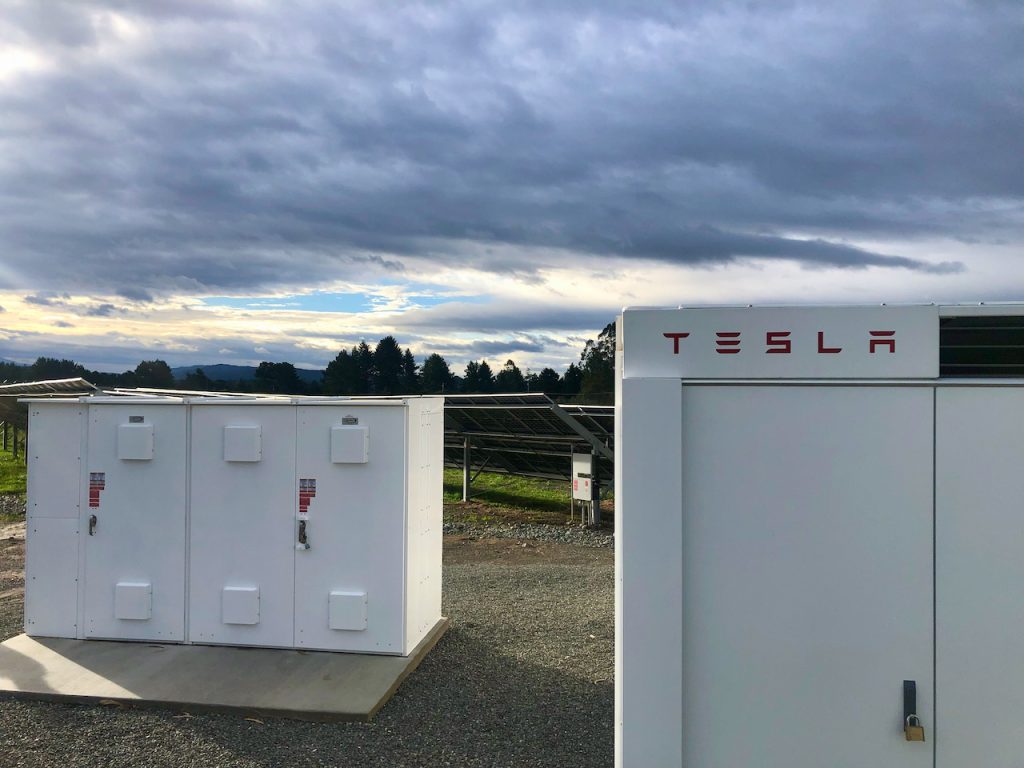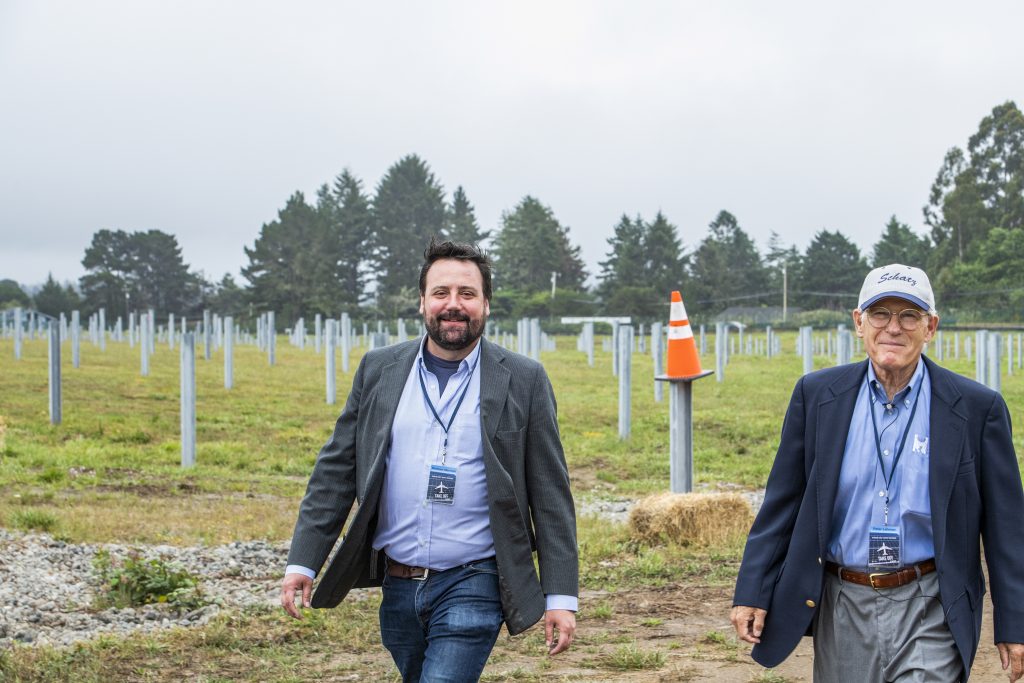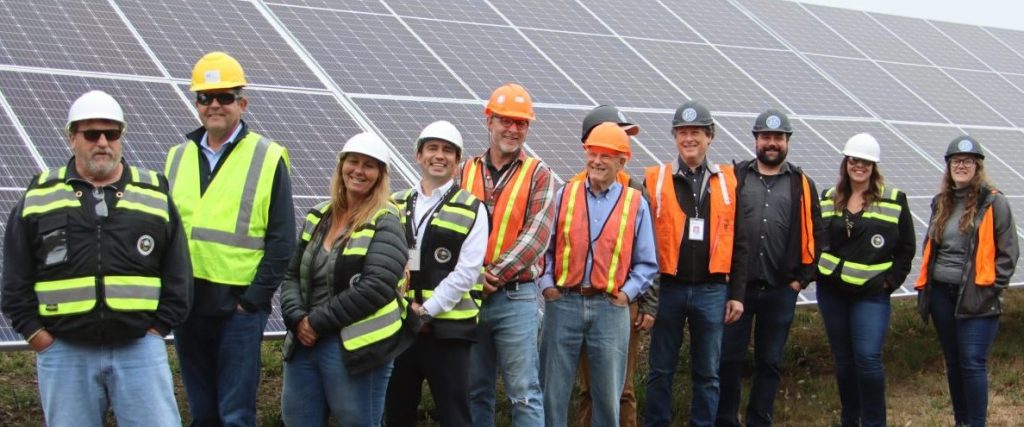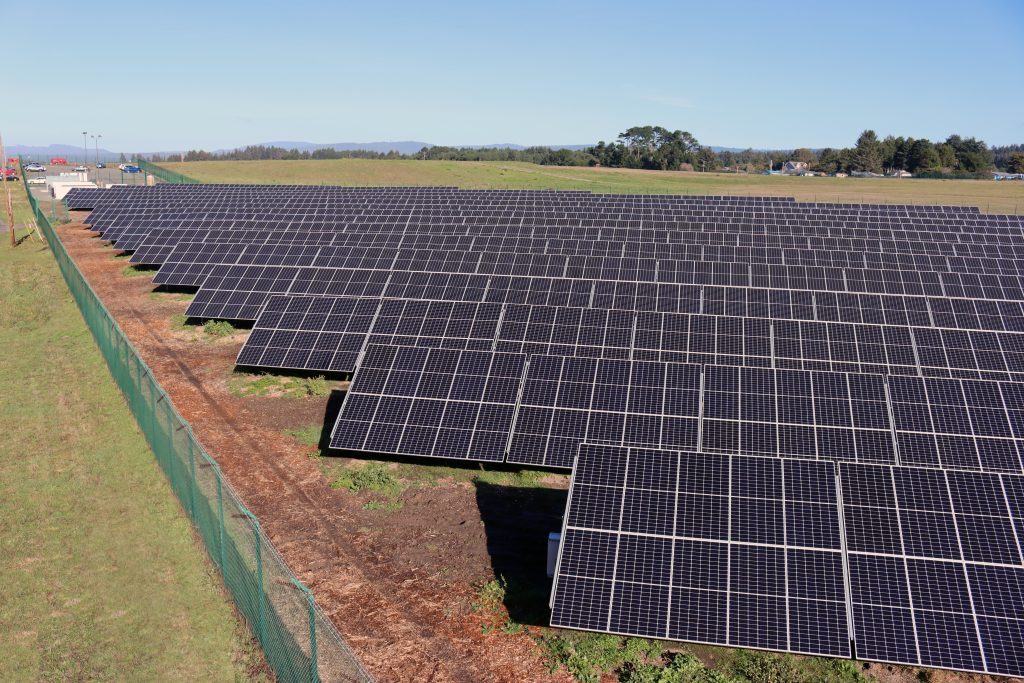Visit RCEA’s microgrid page for Grand Opening Celebration details and request a site TOUR: RedwoodEnergy.org/rcam/




Collaborating for a Clean Energy Future: California’s First 100% Renewable Multi-Customer Microgrid is Now Operational
Redwood Coast Airport’s new solar microgrid serves as a blueprint for energy resilience
Tuesday, June 7 2022
ARCATA, Calif.— California’s first 100% renewable energy, front-of-the-meter, multi-customer microgrid is now fully operational. Located in Humboldt County, California, the microgrid provides energy resilience for the regional airport and US Coast Guard Air Station.
This microgrid was developed through a first-of-its-kind partnership between the Schatz Energy Research Center at Cal Poly Humboldt, the Redwood Coast Energy Authority, Pacific Gas & Electric, the County of Humboldt, TRC, The Energy Authority, Tesla, Inc., and Schweitzer Engineering Labs.
Research and development was supported through a $5 million grant from California’s Electric Program Investment Charge (EPIC) – a statewide program which invests in scientific and technological research to accelerate the transformation of the electricity sector to meet the state’s energy and climate goals – and by $6 million from the Redwood Coast Energy Authority (RCEA), a joint powers agency that provides clean and renewable power to Humboldt County.
A model for resilient, clean energy
“The Redwood Coast Airport Microgrid has ushered in a new and exciting era for the electric grid in California,” says Peter Lehman, Founding Director of the Schatz Center and project lead. “With its successful deployment and the development of new microgrid agreements and tariffs, RCAM has become a role model and beacon to communities across the state who are striving to green their energy supply and bolster their resilience in the face of climate change.”
The Redwood Coast Airport Microgrid (RCAM) features a 2.2-megawatt solar photovoltaic array that is DC-coupled to a 2 megawatt (9 megawatt-hour) battery energy storage system, comprised of three Tesla Megapacks.
During standard blue-sky operations, RCAM generates clean and renewable energy for the North Coast, and participates in the California Independent System Operator (CAISO) wholesale energy markets, including the day-ahead, realtime, and ancillary services markets. By storing solar energy during the day and releasing it onto the grid as needed in the evening and during heavy demand periods, RCAM enables greater utilization of solar, supports grid reliability, and creates an economic model for future microgrids.
When a power outage occurs, the microgrid islands from the main grid and energizes the circuit that encompasses the airport, the adjacent Coast Guard Air Station, and several neighboring facilities. RCAM will provide seamless, ongoing electricity for all customers in the microgrid circuit during any local outages.
As the first microgrid in the CAISO market and the first renewable, front-of-the-meter microgrid system in the state, RCAM is building a replicable business model for renewable microgrid deployment.
Meeting critical resilience goals
The regional California Redwood Coast-Humboldt County Airport (ACV) is located in McKinleyville, California, and serves the greater North Coast community with over 50,000 flights per year, including commercial airline, private, and emergency medical flights. Adjacent to the airport, the US Coast Guard Air Station Humboldt Bay provides search and rescue for 250 miles of rural coastline, from the Mendocino-Sonoma county line to the California-Oregon border.
Roads into Humboldt County are frequently closed by fires and mudslides, making air services a critical factor in regional emergency response.
Cody Roggatz, Humboldt County’s Director of Aviation says that “The California Redwood Coast-Humboldt County Airport (ACV) is a lifeline to our community every day by keeping Humboldt County connected to the world alongside our partners at United Airlines, Avelo Airlines, American Airlines, REACH/Cal-Ore Life Flights, US Coast Guard-Sector Humboldt Bay, and many others. RCAM ensures that we can continue to keep that lifeline open through energy resilience, no matter what happens to the power grid.”
Community microgrids: partnering for resilience
Deploying multi-customer, front-of-the-meter community microgrids requires close coordination between the microgrid design team, the electric utility, and an electricity generation partner who can energize the microgrid when needed. Because these microgrids utilize circuitry that is owned and maintained by the utility, their control systems must be responsive to utility commands and safety needs, while maintaining a clear delineation between utility-owned and generation partner-owned equipment. Furthermore, participating in the wholesale market requires that the system also be responsive to market signals.
- Design and development of the RCAM project was led by Schatz Energy Research Center at Cal Poly Humboldt. The Schatz Center’s microgrid research and development focuses on resilient renewable energy solutions for the California North Coast and beyond.
- The Redwood Coast Energy Authority (RCEA) is the Community Choice Aggregator for Humboldt County, serving 63,000 electric account customers and supporting energy efficiency alongside local, clean and renewable energy solutions. RCEA is responsible for the majority of the Humboldt Bay area’s energy resource procurement, and owns and operates the electricity generation equipment for the microgrid.
- PG&E maintains the regional electricity grid, which serves over 16 million people in Northern and Central California, and owns and operates the microgrid circuit.
“An important success of RCAM was how we were able to work through the complex financial, technical, regulatory, business, and operational hurdles facing this project,” says Dana Boudreau, RCEA’s director of Operations and Infrastructure. “This experience will serve us well as we continue to engage our community in building offshore wind energy, supporting more solar and storage capacity, and developing new community microgrids.”
Part of a growing trend
The unique collaboration between RCAM project partners has resulted in both technical and policy innovations. RCAM is the model for PG&E’s Community Microgrid Enablement Program – which provides technical assistance and cost offsets for community microgrid deployment. Additionally, PG&E’s Microgrid Incentive Program, expected to launch later this year, will leverage a $200 million statewide fund dedicated to deploying clean energy microgrids, to support the critical needs of vulnerable populations and disadvantaged communities.
“The Redwood Coast Airport Microgrid represents the culmination of many years of research, innovation, and collaboration by the world’s leading microgrid experts. Thanks to their hard work, microgrids now play a key role in PG&E’s ongoing efforts to harden our electrical system and enhance local grid resilience throughout Northern and Central California,” says Jason Glickman, Executive Vice President, Engineering, Planning and Strategy, PG&E. “We know how much our customers and communities need reliable energy, and this system not only increases local reliability, but it serves as the foundation for a replicable and scalable model for widely deploying multi-customer microgrids across PG&E’s service area, giving communities a new tool to take a more active role in securing their resilience and clean energy goals.”
Next steps for the North Coast
“RCEA’s goal is to provide our customers with 100% carbon-free electricity by 2025, and 100% local carbon-free electricity by 2030. This project is a major milestone for our clean energy and resilience efforts,” says Matthew Marshall, Executive Director of RCEA. RCEA works closely with schools, fire departments, Native American Tribes, and other local agencies to support community resilience across the North Coast.
Renewable energy microgrids are uniquely suited to help rural Tribes and other communities adapt to climate change and simultaneously mitigate future climate impacts. The Schatz Center is partnering with a number of Tribes in Northern California to support their clean energy, resilience, and climate response efforts.
Cal Poly Humboldt also recently began design of a renewable energy microgrid to support campus resilience through clean generation. This microgrid will be part of the university’s sustainability framework, and will enable students in engineering, environmental sciences, and other programs to gain hands-on experience with innovative climate-friendly technologies.
More information
Visit RCEA’s microgrid page and request a site TOUR: RedwoodEnergy.org/rcam/
- Learn more about RCAM and other microgrids being developed by the Schatz Center: schatzcenter.org/microgrids
- Explore PG&E’s Community Microgrid Enablement Program: pge.com/cmep




